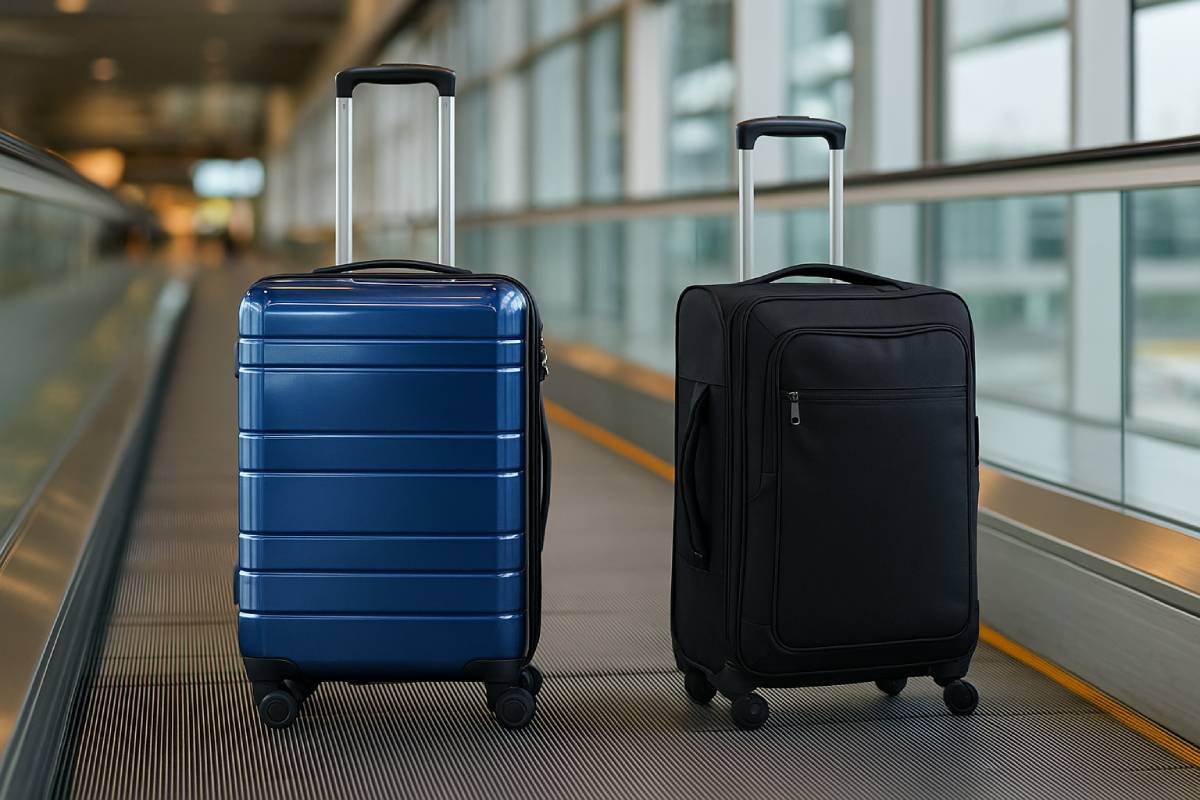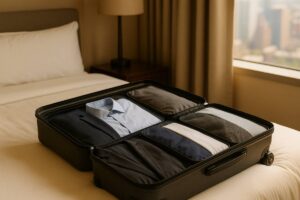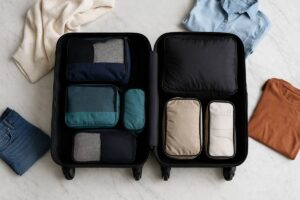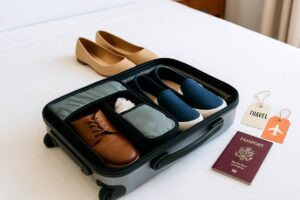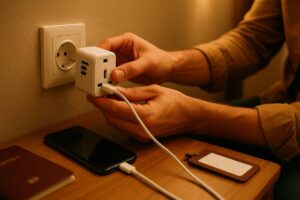Imagine racing through terminals, your luggage smoothly spinning beside you—yet inside, delicate souvenirs jostle without a scratch.
Hard-shell and soft-shell suitcases each promise unique advantages, so choosing between rigid polycarbonate shells that shrug off rain and fabric bags that expand to swallow extra layers can feel daunting.
This guide breaks down the battle of durability versus flexibility, evaluating impact resistance, weather defense, packing capacity, security locks, and maneuverability.
By the end, you’ll know whether a tough exterior or a pliable design best suits your travel style—no guesswork, just informed decisions to elevate every journey with clarity and confidence.
Materials & Construction

Hard Shell Materials
As a travel expert, I’ve seen firsthand how the choice of hardshell material can make or break your luggage’s performance under the rigors of modern travel. Here’s a closer look at the three most common exteriors:
ABS (Acrylonitrile Butadiene Styrene)
ABS is the go-to for budget-friendly, entry-level hardside luggage. According to Consumer Reports, ABS shells are the lightest option but tend to crack more easily when subjected to heavy impact.
- Weight & Density: At just 1.03 g/cm³, ABS is lighter than most plastics.
- Tensile Strength: Around 38 MPa, offering moderate resistance to pulling forces.
- Impact Resistance: Approximately 55 kJ/m² (≈550 J/m) in Izod testing, but prone to brittle failure under sharp blows.
- Flexibility: Limited elongation (~8%) means ABS absorbs less shock before cracking.
Polycarbonate
Polycarbonate strikes a sweet spot between weight and toughness. Consumer Reports highlights its ability to flex rather than shatter, making it ideal for frequent flyers.
- Density: 1.20–1.22 g/cm³, slightly heavier than ABS but still lightweight.
- Tensile Strength: 55–75 MPa, giving it superior resistance to deformation.
- Impact Resistance: 600–850 J/m (Izod), more than enough to withstand tumbling conveyors.
- Elongation: 80–150%, allowing the shell to bend and spring back without permanent damage.
Aluminum (Typically 6061-T6 Alloy)
For travelers seeking premium protection, aluminum cases deliver unmatched rigidity and scratch resistance. They’re heavier, but they’re built to last a lifetime.
- Density: 2.70 g/cm³, roughly three times that of polycarbonate.
- Tensile Strength: ≈310 MPa, depending on temper (e.g., T6).
- Elongation: Around 8% before failure, balancing strength with minimal ductility.
- Impact & Scratch Resistance: Exceptional—metal deforms rather than cracks, though dents are possible (no standardized Izod data).
Hard Shell Materials Comparison
| Material | Density (g/cm³) | Tensile Strength (MPa) | Impact Strength (Izod, J/m) | Elongation at Break (%) |
|---|---|---|---|---|
| ABS | 1.03 | 38 | ≈550 | 8 |
| Polycarbonate | 1.20–1.22 | 55–75 | 600–850 | 80–150 |
| Aluminum | 2.70 | ≈310 | N/A (metal ductility) | 8 |
Soft Shell Fabrics
Soft-shell luggage offers expandable capacity and external pockets but varies widely in durability. Below are the three most popular fabric choices:
Ballistic Nylon
Developed by DuPont for WWII flak jackets, modern ballistic nylon (e.g., 1050D) features a dense 2×2 basket weave that excels at resisting tears and abrasions.
- Denier & Weave: Typically 840–1680 D in a 2×2 basket weave.
- Tear Resistance: Exceptional; layers repel punctures and rips.
- Flexibility: Moderately stiff on first use but softens over time.
- Abrasion Resistance: Top-tier—designed for tactical gear.
Polyester (e.g., 600D Oxford)
Polyester is a versatile, synthetic fiber prized for its low stretch and weather resilience. 600D is common in mid-range luggage.
- Tensile Strength: ~300–400 N in grab/strip tests.
- Flexibility: Elongation at break 15–25%, allowing modest give.
- Abrasion & UV Resistance: Very good; resists fading and mildew.
Canvas (Cotton)
For a classic look, canvas offers natural breathability and durability but requires more care.
- Weight & Weave: Often 10–12 oz/yd² in a plain or duck weave.
- Tear Resistance: 300–1000 PSI (≈2.1–6.9 MPa) before ripping.
- Abrasion Resistance: Up to 50,000 double-rubs in Martindale/Taber tests.
- Flexibility: Low stretch (<10%), giving a firm feel.
Soft Shell Fabrics Comparison
| Fabric | Denier/Weight | Tear Resistance | Flexibility (Elongation) | Abrasion Resistance |
|---|---|---|---|---|
| Ballistic Nylon | 840–1680 D, 2×2 weave | Exceptional; puncture-proof | Moderate; breaks in over time | Excellent; tactical-grade |
| Polyester (600D) | 600 D | Moderate; ~300–400 N grab/strip | 15–25% | Very good; water & UV resistant |
| Canvas (12 oz) | 10–12 oz/yd² plain | 300–1000 PSI before tear | <10% | Up to 50,000 double-rubs |
By understanding these material properties—weight, strength, flexibility, and abrasion tolerance—you can match your luggage choice to your travel style, whether you prioritize lightweight convenience, maximum protection, or classic durability.
Durability & Real-World Performance
Honing in on real-world durability, hardshell suitcases typically absorb shocks by flexing rather than cracking, while softshell bags rely on tough fabrics that bend and rebound under stress. In impact tests, budget-friendly ABS models like the Amazon Basics Expandable Hardside resisted aggressive baseball-bat blows and tabletop drops, with scuffs easily buffed away, while polycarbonate favorites—Béis’s 29″ roller and Samsonite’s Proxis Global carry-on—emerged virtually unscathed even after bat strikes and, in Samsonite’s case, a 130,000-foot fall.
Aluminum-framed cases deform rather than crack, showing minor dents under impact. Meanwhile, softshell luggage—whether ballistic-nylon-built or high-denier polyester—absorbs force through its weave, shrugging off bat hits and 90 cm drops without tears or holes. All models will show marks over time—hardshell exteriors are prone to surface scuffs, and no-give materials magnify scratches—but these blemishes rarely affect structural integrity.
Impact & Scratch Resistance
Hardshell luggage shines in blunt-force tests. Polycarbonate shells flex under impact, returning to shape without cracking, as seen when the Béis 29″ Check-in Roller survived bat strikes and tabletop throws, hiding any marks within its textured shell. ABS-blend designs like the Amazon Basics spinner offer impressive resilience at a lower cost, shrugging off aggressive baseball-bat tests and repeated drops with only minor surface scuffs that can be rubbed out.
Premium aluminum-framed models withstand crushing loads by denting—a dent in a Tumi Contoured carry-on resulted in no shell fractures, preserving interior safety.
Softshell bags prove their mettle through fabric toughness. Ballistic nylon and high-denier polyester carry-ons absorbed multiple bat hits and table-drop tests without developing holes or seam splits, thanks to dense weaves that distribute force across fibers.
While fabric exteriors resist visible scratches, they can still snag or fray on sharp edges—regular seam checks are recommended to catch early wear.
| Luggage Model | Material | Test | Outcome |
|---|---|---|---|
| Amazon Basics Expandable Hardside Spinner | ABS | Baseball bat & tabletop drop | Withstood scuffs & slight scratches; marks buff out easily |
| Béis 29″ Large Check-in Roller | Polycarbonate | Baseball bat & tabletop drop | Emerged looking brand new; texture conceals scuffs |
| Samsonite Proxis Global Carry-On Spinner | Roxkin polycarbonate | Baseball bat & 130,000 ft drop | Virtually unscathed; no structural or surface damage |
| Tumi Signature Contoured Carry-On | Aluminum (6061-T6) | Baseball bat | Minor dent in corner; shell integrity intact |
| Monos Carry-On Pro | Polycarbonate/ABS blend | 90 cm drop cold & loaded | No cracks, dents, or fiber splits under repeated drops |
Water & Weather Resistance
Hard Shell
Rigid shells form effective barriers against rain, sleet, and spills. Sealed seams and unbroken exteriors on hardshell cases prevent water ingress, keeping your gear bone-dry even in downpours. Brands like Antler highlight polycarbonate and polypropylene shells as fully water-resistant, making them ideal for wet tarmacs and snow-covered sidewalks. In lab tests, premium models such as Briggs & Riley’s hardside spinner scored high on water-resistance metrics, shedding surface moisture with ease.
Soft Shell
Fabric exteriors are inherently more porous, but modern textiles often come treated with durable water-repellent (DWR) finishes. Ballistic nylon offers good water shedding, though moisture can accumulate at seams and in exterior pockets if not sealed. Polyester weaves—with typical 600D to 1680D deniers—resist drizzle and light rain but may soak through during prolonged exposure, especially around zippered areas.
Comprehensive testing regimes (e.g., Monos’s quality suite) include water repellency and colour-fastness to water trials, confirming that treated fabrics keep interiors dry under moderate wet conditions.
Key Takeaway:
- For storm-proof reliability, choose a hardshell model with integrated seals and water-resistant locks.
- For light showers and damp climates, select softshell luggage with high-denier, DWR-treated fabrics, and pack sensitive items in protective pouches.
By matching durability and water-defense characteristics to your travel environment, you ensure peace of mind wherever your journey takes you.
Weight & Portability
Below is an expert breakdown of Weight & Portability for both hard-shell and soft-shell luggage, complete with real-world specs and maneuverability insights to help you choose the best ride for your next trip.
Typical Weight Ranges
Empty-weight matters—every ounce you save is more room for essentials (and fewer overweight fees). Below are measured specs from popular models and averages drawn from user-reported data:
| Category | Model / Source | Weight (lbs) | Weight (kg) |
|---|---|---|---|
| Carry-On, Hard Shell | Sherpani Meridian 22″ (100% Polycarbonate) | 6 lb 8 oz (6.5) | 2.95 |
| Travelpro Platinum Elite Hardside Spinner (39 L) | 7.9 | 3.58 | |
| Average Carry-On (all materials) | 7.9 | 3.6 | |
| Carry-On, Soft Shell | Sherpani Latitude Anti-Theft (soft-sided) | 7 lb 10 oz (7.63) | 3.46 |
| Travelpro Platinum Elite Softside Spinner (21″) | 7.8 | 3.54 | |
| Tumi Alpha International Dual-Access (soft shell) | 10.7 | 4.85 | |
| Checked, Hard Shell | Amazon Lightweight 28″ Hardshell | 9.81 | 4.45 |
| Travelpro Platinum Elite 25″ Medium Check-In | 9.8 | 4.45 | |
| Travelpro Crew™ Classic 27″ Medium Check-In | 9.4 | 4.26 | |
| Travelpro Platinum Elite Medium Hardside | 11.1 | 5.03 | |
| Travelpro Maxlite® Air V2 Medium Hardside | 9.4 | 4.26 | |
| Travelpro × Travel + Leisure Set (Medium) | 12.3 | 5.58 | |
| Checked, Soft Shell | Travelpro VersaPack+ Medium Check-In Softside | 9.8 | 4.45 |
| Travelpro Maxlite® 5 25″ Medium Check-In (soft) | 6.8 | 3.09 |
Key takeaways:
- Carry-On Hard Shells: 6.5–9 lbs (2.95–4.1 kg)
- Carry-On Soft Shells: 7.6–10.7 lbs (3.5–4.9 kg)
- Checked Hard Shells: 9.4–12.3 lbs (4.3–5.6 kg)
- Checked Soft Shells: 6.8–9.8 lbs (3.1–4.5 kg)
Maneuverability
How a bag rolls and balances can be just as important as how much it weighs. Here’s what to look for:
Spinner-Wheel Designs
- 360° Spinner Wheels: Four independently rotating wheels let you push or pull in any direction with minimal wrist torque—critical in tight airport aisles.
- Four- vs. Eight-Wheel Spinners: Eight-wheel configurations spread weight over more contact points for an almost “hovering” feel, especially on smooth surfaces; four-wheeled spinners can be easier to steer backward and on uneven ground.
Handle Ergonomics
- Adjustable Height Settings: Telescoping handles with multiple stops (e.g., Travelpro’s two-stop PowerScope Lite with Contour Grip at 38″ and 42.5″) help you maintain an upright posture and reduce shoulder strain.
- Contour & Comfort Grips: Patented rubberized grips on premium lines (Travelpro Platinum Elite’s Contour Grip) cradle your hand, softening pressure points during long hauls.
Balance Under Load
- Low Center-of-Gravity Designs: Tapered or clamshell shapes concentrate weight nearer the wheels, cutting down on tipping and improving stability when rolling.
- Wide-Base Construction: A broader wheelbase and reinforced corner guards (e.g., monocoque polycarbonate shells) create a more stable footprint, even on turns.
By matching weight profiles to your airline’s allowances and assessing maneuverability features (spinner wheels, handle design, balance), you’ll glide through terminals and avoid surprises at the scale.
Ready to compare models and prices?
- Shop recommended hard-shell carry-ons
- Compare soft-shell options by price
Happy travels!
Storage Capacity & Expandability
Below is an expert breakdown of Storage Capacity & Expandability, so you can see exactly how much you’ll pack and how flexible each style is—complete with real-world specs from Travelpro and common conversions for clear comparisons.
Key Findings:
- Internal volume is nearly identical for standard 21″×14″×9″ models: both hard-shell and soft-shell carry-ons pack around 46 L (~2,806 cu in).
- Compact hard shells (55 cm cabin size) trim that down to 41 L (~2,502 cu in).
- International soft-shell spinners (19″×15″×7.75″) often hover around 39 L (~2,382 cu in).
- Soft shells uniquely offer zip-expanders for an extra 2″ of depth (≈4–6 L/244–366 cu in more), plus external pockets (up to three front compartments) for quick-grab items—features hard shells lack.
Volume Comparison
Standard Carry-On (21″ × 14″ × 9″)
| Model | Style | Volume (L) | Volume (cu in) |
|---|---|---|---|
| Platinum® Elite Hardside Spinner | Hard Shell | 46 L | ≈ 2,806 cu in (46 × 61.024) |
| Platinum® Elite Softside Spinner | Soft Shell | 46 L | ≈ 2,806 cu in (46 × 61.024) |
| Maxlite® 5 21″ Expandable Spinner | Soft Shell | 46 L | ≈ 2,806 cu in |
| Platinum® Elite Intl. Carry-On Spinner | Soft Shell | 39 L | ≈ 2,382 cu in (39 × 61.024) |
Compact Cabin Carry-On (55 cm)
| Model | Style | Volume (L) | Volume (cu in) |
|---|---|---|---|
| Compact Expandable Hardside Spinner (55 cm) | Hard Shell | 41 L | ≈ 2,502 cu in (41 × 61.024) |
| Slim Expandable Soft-Shell Spinner (55 cm) | Soft Shell | 41 L (typical) | ≈ 2,502 cu in |
Note: 1 L = 61.0237 cu in.
Expandable Options
- Zip-Expanders: Most soft-side models integrate a 2″ tip-resistant zip-expander, adding roughly 4–6 L (≈ 244–366 cu in) of packing space when you need it—ideal for souvenirs or extra layers.
- External Pockets: Soft shells like the Platinum® Elite Softside feature up to three front zippered pockets for phone, tickets, and keys, plus side slip pockets for water bottles—hard shells offer zero external pockets due to their rigid design.
- Interior Organization: Beyond expanders, soft-sided spinners come with built-in accessory pockets, removable quart-size wet pockets, and tie-down systems for wrinkle-free packing.
By examining these volume specs, conversion factors, and expandability features, you can choose the luggage that best matches your packing habits—whether you prize rigid protection or crave flexible packing room.
Ready to see prices and shop?
- “Shop recommended hard-shell carry-ons”
- “Compare soft-shell options by price.”
Security Features
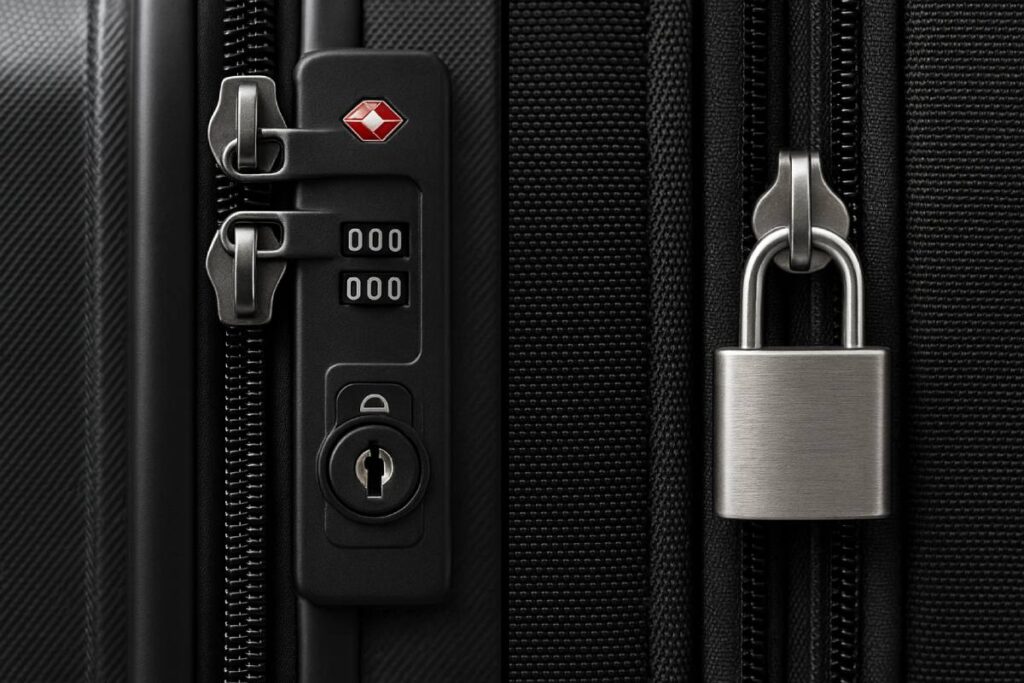
Below is a breakdown of Security Features for hard-shell and soft-shell luggage, helping you weigh the benefits of integrated TSA locks versus removable options, and understand how zipper access compares to sealed-panel designs for theft deterrence.
Key Findings in Brief:
Hard-shell suitcases almost universally ship with built-in, TSA-approved Travel Sentry locks, offering permanent attachment, streamlined aesthetics, and guaranteed compatibility with airport security tools. In contrast, soft-shell bags rely on removable padlocks or zip-tie hacks that you must remember to pack and that thieves can bypass more easily.
As for access, sealed clamshell panels (zipperless or latch-based) eliminate external entry points altogether, whereas zippered compartments on both bag types remain vulnerable to ball-point-pen and seam-slashing tricks.
Integrated Locks
Hard-Shell: Built-In TSA-Approved Locks
- Permanent Integration: Locks are molded into the shell, so there’s no way for a thief to simply remove or swap out the lock without obvious damage.
- Travel Sentry Certified: All built-in locks carry the red Travel Sentry diamond, letting TSA agents open and relock your bag with master keys—no broken zippers or forced entries.
- Aesthetic & Convenience: Seamless design means you never forget the lock at home, and there’s no extra hardware to fumble in your pocket.
- Global Recognition: Over 500 million Travel Sentry locks are in circulation worldwide, accepted at 750+ airports, ensuring consistent security standards.
Soft-Shell: Removable Lock Options
- Padlocks & Cable Locks: You clip or thread these through dual zipper pulls—versatile but easy for thieves to cut or pick if left unattended.
- Zip-Tie & DIY Hacks: Zip ties offer tamper-evidence (you’ll know if TSA opened your bag), but they’re single-use and add little actual resistance.
- Risk of Misplacement: Forgetting your external lock at home or in transit means your bag is unprotected, whereas built-ins are always there.
- Cost & Replacement: External locks can be replaced cheaply, but each new lock introduces another security variable—combination reset, key management, and TSA compliance.
| Feature | Hard-Shell (Built-In) | Soft-Shell (Removable) |
|---|---|---|
| Attachment | Zip-tie shows forced entry, but the padlock cut may not | External padlock/cable, zip-tie, carabiner |
| TSA Compatibility | Travel Sentry master-keyed, red diamond symbol | Permanent, integrated into the shell |
| Tamper Evidence | Visible shell damage if the lock is removed | Always attached, no extra items to pack |
| Convenience | Visible shell damage if the lock removed | Requires remembering and storing lock/zip-ties |
| Security Level | High deterrence for opportunistic theft | Medium deterrence; can be bypassed with tools |
Zipper vs Panel Access
Zippered Compartments
- Universal Design: Nearly every bag uses a zipper, giving quick access but creating a predictable entry point.
- Vulnerabilities: Simple tricks—like slipping a ball-point pen through the coil or prying at a seam—can open most zippers without breaking the lock.
- External Pockets: On soft shells, front and side pockets invite snatch-and-grab theft if left unattended.
Sealed Panel (Clamshell) Designs
- No Exposed Zippers: Zipperless bags use latches or hidden zippers under fabric flaps, eliminating obvious weak points.
- Mechanical Latches: Metal clasps or locks require tools or visible force to breach, increasing the risk that a thief will move on to an easier target.
- Interior Organization: Dividers and mesh pockets remain accessible only after you unlatch the shell, adding an extra barrier to theft.
| Access Type | Pros | Cons |
|---|---|---|
| Zipper | Fast packing, expandable, lightweight | Vulnerable to pen-tricks, seam-slashing, fewer barriers |
| Sealed Panels | No external entry points; latches deter casual thieves | Often heavier, less expandable, slower to open/close |
Price Range & Value
Below is a detailed look at how much you’ll spend—and what you get—across the three major luggage tiers, so you can match your budget to features, durability, and long-term value.
In the budget bracket ($50–$150), you’ll find lightweight, entry-level bags with basic wheels and minimal warranties. Mid-tier options ($150–$300) deliver notable durability upgrades, smoother wheels, and stronger warranty policies that protect your investment. Finally, premium & luxury models ($300+) harness advanced materials—aluminum alloys and woven carbon fiber—for unmatched strength, prestige, and cutting-edge features.
Budget Models ($50–$150)
Entry-level hard and soft shell luggage under $150 offers solid value for occasional travelers, though trade-offs include lighter-gauge plastics, basic inline-skate wheels, and limited warranty coverage.
| Model | Style | Price | Key Trade-Offs |
|---|---|---|---|
| Amazon Basics 20″ Hardside Spinner | Hard Shell | $83 | Thin ABS shell, basic dual-wheel spinners, 1-year warranty |
| Wrangler 20″ Hardside Spinner | Hard Shell | $45.95 | Heavier ABS blend, limited impact resistance |
| Coolife 20″ Carry-On | Soft Shell | $60 | 600D polyester, single-stop handle, 1-year warranty |
| Kenneth Cole Reaction Out Of Bounds 20″ Carry-On | Soft Shell | $67 | 420D polyester, basic wheels, minimal expandability |
| Samsonite Freeform 20″ Carry-On | Hard Shell | $140 | Polypropylene shell, textured finish hides scuffs |
Peter Greenberg notes that single polycarbonate suitcases in this range typically retail for $60–$170, trading off heavy-duty protection for lower price points.
Mid-Tier ($150–$300)
In the $150–$300 range, you’ll see durability upgrades (reinforced corners, tougher shells/fabrics), better wheel systems, and enhanced warranties—helpful for frequent flyers.
| Model | Price | Durability Upgrades | Wheel Quality | Warranty |
|---|---|---|---|---|
| Maxlite® Air V2 Large Check-In Spinner | $212.49 | Inner corner guards, 100% polycarbonate shell flexes upon impact to prevent cracking | Spinner wheels; “double the wheels” design for smooth roll | 100-day easy trial + free return shipping |
| Crew™ Classic 28″ Medium Check-In | $297.49 | Heavy-duty ballistic nylon blend, reinforced seams, scuff-resistant finish | 360° inline-skate spinners standard on this collection | Built-for-a-Lifetime Limited Warranty with Trusted Companion Promise |
Travelpro’s mid-tier lines like Maxlite Air V2 boast reinforced polycarbonate shells and corner guards, while Crew Classic models offer professional-grade durability and spinner wheels designed for tight airport lanes.
Premium & Luxury ($300+)
When budget allows $300 or more, you can step up to cutting-edge materials—real carbon fiber or anodized aluminum frames—that blend extreme strength, lightness, and status. Retail prices here run from $519 to over $1,500.
| Model | Material | Price | Signature Features |
|---|---|---|---|
| Swiss Luggage Carbon Fiber 55 SL Carry-On | 100% real carbon fiber | $945 | TSA-compatible lock, four-wheel setup, ultra-light structural weave |
| MonCarbone Premium Carbon Fiber Travel Goods | Carbon fiber composites | varies ≥$300 | Sleek industrial finish, extreme tensile strength |
| Carbon X 2.0 Limited Edition Noir | 3K-weave carbon fiber | $519 (sale) | Limited-edition design, weave-patterned exterior, luxury branding |
| Skyborne B-2 Carbon Carry-On Trunk | Carbon fiber + aluminum accents | $889 | Silent glider wheels, built-in USB charging, TSA-approved design |
| RIMOWA Original Cabin (Pilot) | Anodized aluminum alloy | $1,550 | Stage-free telescopic handle, Multiwheel® system, signature ribbed shell |
Rimowa’s fully in-house aluminum cases are retail-priced $1,500 to $10,000, celebrated for their enduring design and German engineering.
Across all tiers, balancing price, durability, wheel quality, and warranty will pinpoint the best match for your travel habits—whether you’re a budget-minded occasional flyer or a luxury-seeking frequent traveler.
Maintenance & Care
Maintenance & care are the unsung heroes of long-lasting luggage. Keeping a polycarbonate shell gleaming and your fabric panels stain-free not only preserves aesthetics but also extends functionality, and knowing how manufacturers handle cracks versus tears can save you money down the road. Here’s an expert rundown:
- Cleaning Tips cover gentle yet effective methods for both hard and soft exteriors, avoiding harsh chemicals that can degrade materials.
- Repair & Warranty breaks down the typical coverage for shell cracks, seam tears, zippers, and wheels among leading brands, so you know when you’re fully protected and when normal wear is on you.
Cleaning Tips
Polycarbonate Shells
- Gentle Soap & Water
- Mix a few drops of mild dish soap with warm water.
- Using a soft sponge or microfiber cloth, wipe the entire shell in circular motions—don’t concentrate on one spot to avoid streaks.
- Scuff & Scratch Removal
- Buff minor marks with a dedicated eraser cleaning pad.
- Avoid acetone, ammonia, or benzene-based cleaners—they can leave sticky residues or dull the finish.
- Handle & Wheel Care
- Clean handles, wheels, and zipper pulls with disinfecting wipes or soapy water on a damp cloth.
- Spin wheels against the cloth to dislodge trapped dirt.
- Dry Thoroughly
- After rinsing away soap, dry with a clean, soft towel to prevent water spots and mildew.
- Periodic Disinfection
- Wipe high-touch areas (handles, side grips) with alcohol-based or bleach-diluted solutions for hygiene, especially during peak travel seasons.
Fabric Panels (Soft Shells)
- Spot Cleaning
- Treat stains promptly with a mild detergent solution.
- Use a soft brush or sponge to gently agitate, then blot dry—never scrub aggressively.
- Hand-Washing
- If the interior manufacturer tag allows, hand-wash panels in warm water with mild soap; avoid full immersion to protect internal frames and zippers.
- Machine Washing (Removable Liners)
- Remove any washable liners or pockets; launder on delicate or soak in soapy water, then air dry.
- Air Drying
- Always let fabric panels air dry fully, away from direct heat or sunlight, to prevent shrinkage and UV fading.
- Fabric Protectant
- Apply a DWR (durable water-repellent) spray annually to restore water resistance and repel stains.
Repair & Warranty
Manufacturers vary in what they cover under “defects” versus “wear and tear.” Use the table below as a quick reference:
| Brand | Warranty Type | Shell Cracks | Seam Tears | Zipper Failures | Wheels/Handles | Not Covered |
|---|---|---|---|---|---|---|
| Away | Limited Lifetime | ✅ Covered | ✅ Covered (if non-functional) | ✅ Covered | ✅ Covered | Cosmetic scratches, dents |
| Traveler’s Choice | Limited Warranty | ❌ Not covered | ❌ Not covered | ❌ Not covered | ❌ Not covered | Damage from misuse or overpacking |
| Aer | 2-Year Limited | ✅ Covered | ✅ Covered | ✅ Covered | ✅ Covered | Cosmetic wear; stains; UV damage |
| BÉIS | Limited Lifetime | ✅ Covered | ❌ Not covered | ✅ Covered | ✅ Covered | Cosmetic damage; fabric discoloration |
| Skyway | 1-Year Limited | ❌ Not covered | ✅ Covered | ✅ Covered | ✅ Covered | Cosmetic marks; normal wear |
| Herschel | Limited Lifetime | ✅ Covered | ✅ Covered | ✅ Covered | ✅ Covered | Orrr, subject to local laws; cosmetic |
Key Points
- Shell Cracks: Premium brands (Away, Aer, Herschel) typically cover cracks or breaks under lifetime or multi-year warranties.
- Seam Tears: Fabric splits often fall under workmanship guarantees—check if “non-functional” tears qualify.
- Zipper Failures & Hardware: Most mid-to-high-end lines include broken zippers, wheels, and handles in their coverage.
- Cosmetic Exclusions: Nearly all warranties exclude scratches, dents, stains, and UV fading—these are considered normal wear.
Pro Tip: Register your luggage with the manufacturer upon purchase to activate warranties and speed up any future claims. Always keep your receipt—warranties typically begin on the original purchase date.
By following these maintenance best practices and understanding warranty fine print, you’ll maximize the return on your luggage investment and minimize surprise repair costs down the line.
Airline Compatibility & Restrictions
Below is an expert overview of Airline Compatibility & Restrictions, so you can pack and travel with confidence—complete with size charts, fee breakdowns, and regional nuances to keep you ahead of the gate.
In the U.S., standard carry-on dimensions are 22″×14″×9″ (≤45 linear inches), while checked bags are typically limited to 62 linear inches (length + width + height). Domestic airlines generally impose a $35 fee for the first checked bag and $45 for the second, with overweight charges ranging from $100 for 51–70 lbs to $200 for 71–100 lbs. Empty luggage weight directly reduces packable weight, so selecting lighter suitcases (4–6 lbs for carry-ons) can help avoid overage fees.
Low-cost carriers often enforce stricter size limits—Ryanair basic fares allow only a 40×25×20 cm personal item—and international flights may vary up to 22″×15″×10″.
Size Limits
Domestic Carry-On & Checked
| Type | Max Dimensions | Linear Inches | Notes |
|---|---|---|---|
| Carry-On (US) | 22″ (L) × 14″ (W) × 9″ (H) | ≤ 45 in | Includes wheels/handles; sizer-bin tested by Travelpro |
| Checked (US) | Any orientation ≤ 62 in total | ≤ 62 in | 62 in = height + width + depth; oversized bags incur extra fees |
International Variations
- Standard Int’l Carry-On: Often 22″ × 15″ × 10″ (55 × 38 × 25 cm).
- Airline Exceptions: Some European carriers (e.g., British Airways) allow slightly larger or smaller carry-ons—always check your airline’s published dimensions.
- Gate-Check Risk: A U.S.-legal 22×14×9 bag may be too large for certain international or low-cost sizer bins.
Weight Fees
Checked Baggage Fees
| Bag Number | Fee (One-Way) | Notes |
|---|---|---|
| 1st checked bag | $35 | Standard on most U.S. carriers |
| 2nd checked bag | $45 | |
| 3rd checked bag | $150 | Some carriers charge up to $150 or more |
| Overweight 51–70 lbs | $100 | Applies per bag |
| Overweight 71–100 lbs | $200 | Bags >100 lbs often prohibited or require cargo service |
Tip: If your empty suitcase weighs 10 lbs and your airline’s limit is 50 lbs, you can pack only 40 lbs of contents—choose a carry-on under 6 lbs to maximize your allowance.
Regional Variations
Low-Cost Carriers
| Airline | Carry-On / Personal Item | Checked Baggage |
|---|---|---|
| Ryanair | 40 × 25 × 20 cm (personal only) | Charged by piece; no free checked bags on lowest fares |
| EasyJet | 56 × 45 × 25 cm (no weight limit) | First bag ~£6–£12; overweight/oversize fees apply |
| Wizz Air | 40 × 30 × 20 cm (free) | Cabin bag 55 × 40 × 23 cm for Plus fares; fees for others |
| AirAsia | 56 × 36 × 23 cm (7 kg max) | Charges by kg; economy ~RM30–RM80 per 20 kg block |
Full-Service & International
- Asia & Middle East (e.g., Emirates, Qatar): Often include 1st checked bag free in economy; weight limits 23 kg–30 kg varying by region and class.
- Europe & UK Legacy Carriers: Usually 8 kg–12 kg for carry-on plus 23 kg checked; fees for extras or overweight.
- Latin America & Africa: Standards range from 55 × 35 × 25 cm carry-on to 23 kg–32 kg checked, depending on carrier and fare class.
By matching your luggage size, weight, and fare-class allowances to each airline’s rules—and opting for lightweight designs—you’ll minimize unexpected fees, breeze through boarding, and make the most of your travel investment.
Travel Scenarios & Recommendations
Whether you’re darting between meetings, packing for a beach getaway, or heading off-road, the right suitcase can make all the difference. From Travelpro’s pilot-tested Platinum Elite to Samsonite’s bestselling Freeform, and from Thule’s rugged duffels to Amazon Basics’ entry-level spinners, these picks balance performance, price, and personality.
Below you’ll find tailored recommendations—complete with weights, prices, and standout features—so you can choose the perfect bag for your next adventure.
Frequent Business Travelers
Professional appearances, rock-solid durability, and effortless rolling are non-negotiable when your luggage doubles as a mobile office.
Business pros swear by Travelpro’s Platinum Elite Hardside Spinner, which survived farm-yard stress tests and still glides on MagnaTrac® wheels—perfect for racing through terminals. Tumi’s Alpha International Dual Access Carry-On combines ballistic nylon toughness with a removable garment sleeve and dual-access panels for last-minute prep. For a more style-driven choice, Delsey’s Chatelet Air 2.0 marries a textured polycarbonate shell with leather-style accents and smooth-rolling spinners.
| Model | Weight | Price | Key Feature |
|---|---|---|---|
| Travelpro Platinum Elite Hardside | 7.8 lbs (3.54 kg) | ~$260 | MagnaTrac® wheels, polycarbonate shell, USB port |
| Tumi Alpha Int’l Dual Access Carry-On | 10.7 lbs (4.85 kg) | ~$779 | Ballistic nylon, removable garment sleeve |
| Delsey Chatelet Air 2.0 21″ Spinner | 8.0 lbs (3.63 kg) | ~$220 | Leather-style trims, telescopic handle |
Occasional Vacationers
Family getaways and summer escapes demand a balance of cost, capacity, and reliability.
Samsonite’s Freeform 28″ Checked Luggage offers 44 L of expandable space, a built-in TSA lock and spinner wheels that make airport navigation a breeze—now on sale under $200. For ultimate value, the Travelers Club Midtown Hardside Set bundles a 22″ carry-on, 28″ check-in, toiletry bag and personal tote for about $130.
Travelpro’s mid-tier Platinum Elite Medium Check-In Spinner adds corner guards and a flex-tested shell for roughly $210, ideal for hauling everyone’s souvenirs.
| Model | Price | Capacity | Notes |
|---|---|---|---|
| Samsonite Freeform 28″ | $200† | 44 L | Expandable, TSA lock, sale price |
| Travelers Club Midtown Set | $130 | 22″ + 28″ | Includes toiletry bag & personal tote |
| Travelpro Platinum Elite Medium Check-In | $210 | 67 L | Corner guards, polycarbonate |
Adventure / Outdoor Travelers
Whether it’s a river rafting trip or a mountain trek, you need bags that shrug off water, mud, and rough handling.
The Thule Chasm Sport Duffel 90 L combines a 900D tarpaulin shell with a DWR finish and a padded base—perfect for gear-heavy adventures. Yeti’s Panga 50 L is fully waterproof, thanks to its high-density nylon and TIZIP® zipper, so your kit stays bone-dry. Eagle Creek’s Cargo Hauler Duffel uses Bi-Tech Armor Lite fabric to resist abrasion and shed water, all while weighing under 3 lbs.
| Model | Price | Material | Key Feature |
|---|---|---|---|
| Thule Chasm Sport Duffel 90 L | $140 | 900D tarpaulin polyester | DWR finish, padded base |
| Yeti Panga 50 L | $299 | High-density nylon | 100% waterproof, TIZIP® zipper |
| Eagle Creek Cargo Hauler Duffel | $150 | Bi-Tech Armor Lite nylon | Lightweight, water-repellent |
Budget-Conscious Shoppers
Great performance doesn’t have to cost a fortune—these options under $150 punch above their weight.
Amazon Basics’ 21″ Expandable Spinner weighs just 6 lbs, hides scratches in its textured finish, and retails for only $57. Travelers Club’s Midtown Set (22″ + 28″) for $130 includes a toiletry bag and personal tote for a complete travel kit. For a soft-side pick, Coolife’s 20″ Carry-On (about $60) features 600D polyester, a single-stop handle, and zip-expander for last-minute items.
| Model | Price | Style | Notes |
|---|---|---|---|
| Amazon Basics 21″ Spinner | $57 | Hard Shell | Expandable, textured finish |
| Travelers Club Midtown Set | $130 | Hard Shell | Set includes toiletry & tote |
| Coolife 20″ Carry-On | $60 | Soft Shell | 600D polyester, expandable |
Luxury Enthusiasts
When only the finest materials and craftsmanship will do, these top-tier cases deliver prestige and performance.
RIMOWA’s Original Cabin Pilot is built from anodized aluminum, features Multiwheel® technology, and retails around $1,550—an icon of German engineering. Sterling Pacific’s 40 L Cabin Travel Case blends aerospace-grade aluminum with leather accents, silent wheels, and a premium suede interior for about $690.
Monos’ Carry-On Pro uses a polished polycarbonate shell with aluminum bumpers and carries a lifetime warranty—all for $259.
| Model | Price | Material | Signature Feature |
|---|---|---|---|
| RIMOWA Original Cabin Pilot | $1,550 | Anodized aluminum | Multiwheel®, stage-free handle |
| Sterling Pacific 40 L Cabin Travel Case | $690 | Aerospace-grade aluminum | Silent wheels, suede lining |
| Monos Carry-On Pro | $259 | Polycarbonate + aluminum | Lifetime warranty, sleek design |
First-Time Buyers
If you’re new to luggage shopping, hybrids combine the best of hard and soft shells for versatility and peace of mind.
Away’s The Carry-On Flex packs a polycarbonate shell fronted by a water-resistant nylon pocket, giving you both impact protection and quick-access storage—around $260. Eastpak’s Resist’r Case uses a zipperless clamshell frame for extra security, priced at $130. For a pro-grade hybrid, Tumi’s Alpha International Dual Access (ballistic nylon plus engineered shell panels) offers style and structure for roughly $779.
| Model | Price | Hybrid Feature | Benefit |
|---|---|---|---|
| Away The Carry-On Flex | $260 | Polycarbonate + nylon front pocket | Expandable convenience, impact protection |
| Eastpak Resist’r Case | $130 | Clamshell frame, no external zippers | Theft deterrent, solid clamshell security |
| Tumi Alpha Int’l Hybrid Carry-On | $779 | Nylon body + rigid shell panels | Professional look, versatile access |
No matter your travel style, matching your suitcase to your needs—whether that’s a slick spinner for business, a budget set for family fun, or a carbon-fiber premium carry-on—will transform your trip from stressful to seamless. Happy packing!
Conclusion
After surveying materials, durability tests, capacity, security, weight, and price, it’s clear there’s no one-size-fits-all winner in the hard shell vs soft shell debate; each style outperforms in distinct travel conditions. Hard shells—built with ABS, polycarbonate, or aluminum—offer superior impact resistance and water-shedding performance, ideal for protecting fragile items in checked baggage.
Soft shells—crafted from ballistic nylon, high-denier polyester, or canvas—bring expandable capacity, multiple pockets, and lighter weights suited for cabin travel and overpacked getaways.
If maximum protection tops your priority list, choose a hard-shell model with integrated TSA-approved locks and rigid clamshell panels that shrug off drops and rainstorms. Expect empty weights around 6–12 lbs, which can impact airline weight limits and fees—plan accordingly by measuring your packed bag at home. Conversely, soft-shell luggage allows 2″ expandable zip sections (adding 4–6 L), external slip and zip pockets for quick access, and weights often below 8 lbs for mid-size carry-ons.
However, softer exteriors may be vulnerable to seam tears and water seepage during heavy downpours, so be sure to pack delicate items in protective sleeves or waterproof pouches. Your budget also guides the choice—entry-level options under $150 offer basic protection and wheels, mid-tier $150–$300 strike a balance of durability and smoother spinners, while premium $300+ suitcases boast carbon fiber or anodized aluminum for lifelong use.
By matching your luggage choice to your travel style—whether ferrying breakables, hauling souvenirs, or navigating tight overhead bins—you’ll ensure each trip is smoother, safer, and more organized.
FAQs
What’s the main advantage of a hard-shell suitcase?
Hard shells deliver superior impact and water resistance thanks to rigid exteriors made from polycarbonate or aluminum, safeguarding fragile items in checked baggage.
Can soft-shell luggage prevent moisture damage?
Most high-denier fabrics (600D–1680D) come with DWR coatings that shed light rain, but prolonged exposure can penetrate seams. Pack essentials in waterproof pouches for extra security.
How much weight can I save with a lightweight carry-on?
Choosing a hard-shell carry-on under 7 lbs can free up 8–10 lbs for your belongings before hitting the typical 50 lb checked limit, reducing overage fees.
Do integrated locks really matter?
Yes—built-in TSA-approved locks on hard shells allow secure, damage-free inspections, whereas soft shells rely on separate padlocks that may not be TSA-approved and risk misplacement.
Is expandable soft-shell luggage worth it?
Absolutely. Zip expanders can add up to 6 L (≈366 cu in) for oversized souvenirs, but beware that overexpansion can push dimensions beyond airline limits.

